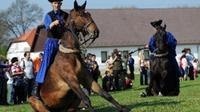Full-Day Private Tour to Debrecen and Hortobagy National Park from Budapest
Budapest, Hungary
Trip Type: Day Trips
Duration: 12 hours
The Hungarian puszta, the Hortobagy National Park - home to shepherds (csikos, gulyas), tsarda (csarda), the famous Hungarian Grey Cattle and stud - is a UNESCO World Heritage Site. Discover the Hungarian puszta and the nearby Debrecen with private guide!
More About This Activity All Day Trips →
The Hungarian puszta, the Hortobagy National Park - home to shepherds (csikos, gulyas), tsarda (csarda), the famous Hungarian Grey Cattle and stud - is a UNESCO World Heritage Site. Discover the Hungarian puszta and the nearby Debrecen with private guide!
In Hortobagy we visit the famous Nine-Span-Bridge and the Herdsmen’s Museum, which shows how people of the 'puszta' lived and lives today, the ancient Hungarian animal breeds, typical clothing, crafts, pottery and also a model of a herdsman's hut. Optionally we take a horse carriage tour in the 'puszta' introducing its natural treasures, herdsmen’s traditions, horsemen and stud, the Hungarian Gray Cattle herd, other Hungarian domestic animals typical to the area in their habitat, the cartwright- and smith museum, the cart exhibition, the black pottery workshop of Nádudvar and the stock stables of the 300 years old stud. The migration of cranes over Hortobagy is a memorable late autumn experience. The number of cranes passing over the Hortobágy at the end of October can be as high as 85000.
Lunch of typical Hungarian cuisine in a "csárda" can be arranged in Debrecen or Hortobágy. For Hortobagy visitors, seeing a horse riding show is usually a must: the Hungarian cowboys - called the "Csikós" - demonstrate some of the traditional equestrian exercises such as making the horse sit and lay down, or riding while standing on the back of the horses.
Debrecen is the second largest Hungarian city, once upon a time was even the capital of Hungary. Debrecen embraced the Protestant Reformation quite early, earning the moniker "Calvinist Rome". During our walk we visit the Petőfi Square, the famous Piac Street (with the Alföld Palace, City Hall, County Hall, Csokonai Theater, Small White Church, Golden Bull Hotel, and other sights), Bishop’s Palace, the nearby St. Andrew Church, Red Tower and Reformed College, (dates back to 1538), and lastly the Great Church, which with its imposing, bright yellow facade and famous twin clock towers have become a much-loved symbol of the city. The tour in the innercity of Debrecen ends with visiting Déri Museum, where the world famous Christ-Trilogy of Mihály Munkácsy in Debrecen is exhibited.
Lunch of typical Hungarian cuisine in a "csárda" can be arranged in Debrecen or Hortobágy. For Hortobagy visitors, seeing a horse riding show is usually a must: the Hungarian cowboys - called the "Csikós" - demonstrate some of the traditional equestrian exercises such as making the horse sit and lay down, or riding while standing on the back of the horses.
Debrecen is the second largest Hungarian city, once upon a time was even the capital of Hungary. Debrecen embraced the Protestant Reformation quite early, earning the moniker "Calvinist Rome". During our walk we visit the Petőfi Square, the famous Piac Street (with the Alföld Palace, City Hall, County Hall, Csokonai Theater, Small White Church, Golden Bull Hotel, and other sights), Bishop’s Palace, the nearby St. Andrew Church, Red Tower and Reformed College, (dates back to 1538), and lastly the Great Church, which with its imposing, bright yellow facade and famous twin clock towers have become a much-loved symbol of the city. The tour in the innercity of Debrecen ends with visiting Déri Museum, where the world famous Christ-Trilogy of Mihály Munkácsy in Debrecen is exhibited.
Debrecen offers many programs and festival all over the year, but the most famous is the Flower Festival held on 20th August. This feast has got a 100 years of tradition, which has recently come to mean not just a single day of fun but a week-long fiesta in the spirit of music, dance, and myriad flowers forming living statues and all kind of decorations.
« Go Back

